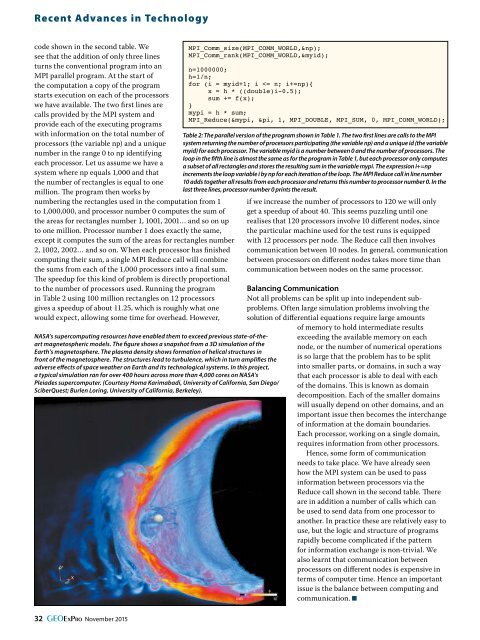Iraqi Kurdistan All in the Timing
GEO_ExPro_v12i6
GEO_ExPro_v12i6
You also want an ePaper? Increase the reach of your titles
YUMPU automatically turns print PDFs into web optimized ePapers that Google loves.
Recent Advances <strong>in</strong> Technology<br />
code shown <strong>in</strong> <strong>the</strong> second table. We<br />
see that <strong>the</strong> addition of only three l<strong>in</strong>es<br />
turns <strong>the</strong> conventional program <strong>in</strong>to an<br />
MPI parallel program. At <strong>the</strong> start of<br />
<strong>the</strong> computation a copy of <strong>the</strong> program<br />
starts execution on each of <strong>the</strong> processors<br />
we have available. The two first l<strong>in</strong>es are<br />
calls provided by <strong>the</strong> MPI system and<br />
provide each of <strong>the</strong> execut<strong>in</strong>g programs<br />
with <strong>in</strong>formation on <strong>the</strong> total number of<br />
processors (<strong>the</strong> variable np) and a unique<br />
number <strong>in</strong> <strong>the</strong> range 0 to np identify<strong>in</strong>g<br />
each processor. Let us assume we have a<br />
system where np equals 1,000 and that<br />
<strong>the</strong> number of rectangles is equal to one<br />
million. The program <strong>the</strong>n works by<br />
number<strong>in</strong>g <strong>the</strong> rectangles used <strong>in</strong> <strong>the</strong> computation from 1<br />
to 1,000,000, and processor number 0 computes <strong>the</strong> sum of<br />
<strong>the</strong> areas for rectangles number 1, 1001, 2001… and so on up<br />
to one million. Processor number 1 does exactly <strong>the</strong> same,<br />
except it computes <strong>the</strong> sum of <strong>the</strong> areas for rectangles number<br />
2, 1002, 2002… and so on. When each processor has f<strong>in</strong>ished<br />
comput<strong>in</strong>g <strong>the</strong>ir sum, a s<strong>in</strong>gle MPI Reduce call will comb<strong>in</strong>e<br />
<strong>the</strong> sums from each of <strong>the</strong> 1,000 processors <strong>in</strong>to a f<strong>in</strong>al sum.<br />
The speedup for this k<strong>in</strong>d of problem is directly proportional<br />
to <strong>the</strong> number of processors used. Runn<strong>in</strong>g <strong>the</strong> program<br />
<strong>in</strong> Table 2 us<strong>in</strong>g 100 million rectangles on 12 processors<br />
gives a speedup of about 11.25, which is roughly what one<br />
would expect, allow<strong>in</strong>g some time for overhead. However,<br />
MPI_Comm_size(MPI_COMM_WORLD,&np);<br />
MPI_Comm_rank(MPI_COMM_WORLD,&myid);<br />
NASA’s supercomput<strong>in</strong>g resources have enabled <strong>the</strong>m to exceed previous state-of-<strong>the</strong>art<br />
magnetospheric models. The figure shows a snapshot from a 3D simulation of <strong>the</strong><br />
Earth’s magnetosphere. The plasma density shows formation of helical structures <strong>in</strong><br />
front of <strong>the</strong> magnetosphere. The structures lead to turbulence, which <strong>in</strong> turn amplifies <strong>the</strong><br />
adverse effects of space wea<strong>the</strong>r on Earth and its technological systems. In this project,<br />
a typical simulation ran for over 400 hours across more than 4,000 cores on NASA’s<br />
Pleiades supercomputer. (Courtesy Homa Karimabadi, University of California, San Diego/<br />
SciberQuest; Burlen Lor<strong>in</strong>g, University of California, Berkeley).<br />
n=1000000;<br />
h=1/n;<br />
for (i = myid+1; i


